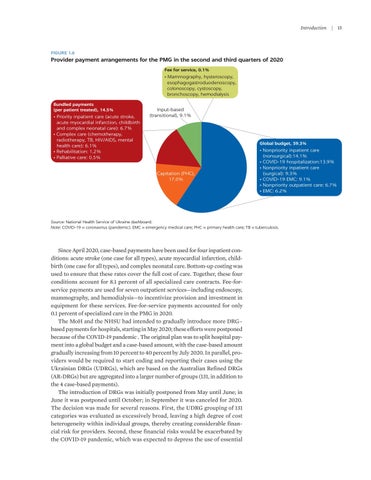Introduction
|
FIGURE 1.6
Provider payment arrangements for the PMG in the second and third quarters of 2020 Fee for service, 0.1%
• Mammography, hysteroscopy, esophagogastroduodenoscopy, colonoscopy, cystoscopy, bronchoscopy, hemodialysis Bundled payments (per patient treated), 14.5%
• Priority inpatient care (acute stroke, acute myocardial infarction, childbirth and complex neonatal care): 6.7% • Complex care (chemotherapy, radiotherapy, TB, HIV/AIDS, mental health care): 6.1% • Rehabilitation: 1.2% • Palliative care: 0.5%
Input-based (transitional), 9.1%
Global budget, 59.3%
Capitation (PHC), 17.0%
• Nonpriority inpatient care (nonsurgical):14.1% • COVID-19 hospitalization:13.9% • Nonpriority inpatient care (surgical): 9.3% • COVID-19 EMC: 9.1% • Nonpriority outpatient care: 6.7% • EMC: 6.2%
Source: National Health Service of Ukraine dashboard. Note: COVID-19 = coronavirus (pandemic). EMC = emergency medical care; PHC = primary health care; TB = tuberculosis.
Since April 2020, case-based payments have been used for four inpatient conditions: acute stroke (one case for all types), acute myocardial infarction, childbirth (one case for all types), and complex neonatal care. Bottom-up costing was used to ensure that these rates cover the full cost of care. Together, these four conditions account for 8.1 percent of all specialized care contracts. Fee-forservice payments are used for seven outpatient services—including endoscopy, mammography, and hemodialysis—to incentivize provision and investment in equipment for these services. Fee-for-service payments accounted for only 0.1 percent of specialized care in the PMG in 2020. The MoH and the NHSU had intended to gradually introduce more DRG– based payments for hospitals, starting in May 2020; these efforts were postponed because of the COVID-19 pandemic . The original plan was to split hospital payment into a global budget and a case-based amount, with the case-based amount gradually increasing from 10 percent to 40 percent by July 2020. In parallel, providers would be required to start coding and reporting their cases using the Ukrainian DRGs (UDRGs), which are based on the Australian Refined DRGs (AR-DRGs) but are aggregated into a larger number of groups (131, in addition to the 4 case-based payments). The introduction of DRGs was initially postponed from May until June; in June it was postponed until October; in September it was canceled for 2020. The decision was made for several reasons. First, the UDRG grouping of 131 categories was evaluated as excessively broad, leaving a high degree of cost heterogeneity within individual groups, thereby creating considerable financial risk for providers. Second, these financial risks would be exacerbated by the COVID-19 pandemic, which was expected to depress the use of essential
15

